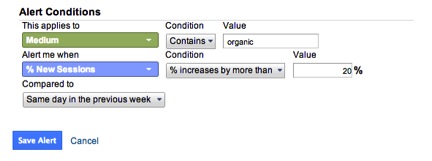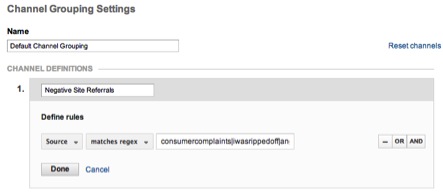Using Google Alerts And Google Analytics For Online Reputation Management
What is Online Reputation Management?

“Online Reputation Management”, or ORM, can be thought of simply as SEO combined with online public relations and social monitoring – how you or your brand is perceived online. How can you know what your online reputation is? Is it possible to measure if your reputation is affecting revenue? Since search optimization plays a huge role in a brand’s reputation, the two are often connected. However in addition to a strong SEO effort, there are several methods to manage your online reputation.
Many software-as-a-service solutions monitor conversation online – from free widgets to enterprise-level applications. These SaaS platforms are great for in-house customer service outreach and monitoring conversations on Twitter and some public Facebook pages. However a major investment may not be not worth it if you are looking for clean, reliable, consistent data.
Facebook, other social networks, forums, news and aggregator sites have changing privacy settings, nofollows and robots.txt to prevent site crawling which can block ORM monitoring software from finding keywords. Again, these providers may prove useful for other purposes, but I believe there is no catch-all ORM tool currently. The good news is that you can use free tools like Google Alerts and Google Analytics to begin to understand and measure your online reputation.
How To Begin
First, we’ll think about some key aspects of online reputation management. If someone has never heard of your brand before, what type of impression are they greeted with online? Seeing how users find and interact with your site is a step toward understanding your online reputation. Some important things relating to your online reputation are:
- Organic Search
- Traffic Referrals
- Social Media
- Mentions on business listings and review sites
Organic Search: Google Alerts
Before setting alerts, it’s a good idea to audit your search results pages on Google to start thinking about keywords that you want to monitor. Keep in mind that this is just a keyword brainstorming exercise, as Google’s search results pages will look different based on a multitude of algorithm factors, including where your IP address is located and what device you are using. The SERPs you see are not set in stone and are not what 100% of all users are seeing when they search for the same terms as you.
When you begin to type in your brand’s name in the search bar, what autocomplete terms does Google suggest? What types of links show up on the first few pages and what types of keywords are associated with the brand name? Try searching for negative keywords with your brand. Does anything show up? As you perform these searches, keep a list of these words and sites.
For this example, we’ll choose four buckets of keywords- branded, branded positive, branded negative and industry. Setting up alerts for both positive and negative associations gives you a chance to take advantage of positive online PR as well as getting on top of the negative as quickly as possible. Setting up alerts related to the industry as a whole is also a good practice to keep tabs on industry developments that are gaining rank, new competitors, and the overall atmosphere and mood surrounding your industry.
As you set up your alerts, you’ll notice the options to email weekly, daily or as-it-happens. If you are monitoring a large client, a good method is to set branded terms to daily or weekly, positive and negative terms to as-it-happens, and industry keywords to weekly. For demonstration purposes, we will use the brand Lululemon.
Branded:
The brand’s name(s) and the brand’s common misspellings.
Examples:
- Lululemon
- Lullelemon
- Lulu lemon
- lulemon
Branded positive:
The brand’s name along with positive keywords that may be associated with it or have been in the past.
Examples:
- Lululemon best
- Love lululemon
- Lululemon favorites
- Wearing lululemon
Branded negative is the same general idea, only using negative terms.
Examples:
- Lululemon refund
- Lululemon awful
- Lululemon lawsuit
- Lululemon rip off
- Lululemon controversy
And finally, some industry terms and phrases for your weekly digest:
Examples:
- Best athletic stores
- High performance running gear
- Hot yoga outifts
- Lululemon or under armour
Traffic Referrals, Social Media and Custom Channel Groupings: Google Analytics
Below are some metrics to measure that shed some light on your brand’s online reputation.
Overall Site Traffic minus CPC and Paid search
Looking at the overall traffic is always a good starting point for an analysis. You can create custom report or dashboard to focus solely on managing this type of monitoring. Since reputation deals with opinion, traffic from non-paid sources will be more relevant. To accomplish this, simply add an exclude filter on your report or dashboard for medium matching regex cpc|ppc.
Don’t forget to add annotations marking occurrences you think may affect your online reputation. Notable events can include: a retweet from an industry leader, a posting of a YouTube review, a mention on a high-traffic blog or an article in a local news site. Annotations make it easier to observe whether such events cause spikes in overall site traffic, social referrals and organic search traffic.
Organic Traffic spike with Custom Alert
Monitoring for spikes in organic traffic is also valuable. If there was a story posted about the company or if word-of-mouth rumors are gaining traction, the first thing people are going to do is search for your brand’s name and possibly go to your site to investigate what the conversation is about. A good practice is to also add a custom alert in analytics, so if traffic from organic search climbs by a certain percent (let’s say 20%), an alert email is sent. This way, you can know when to check out the SERPS and look at your social network activity a little more closely to see why more people may be coming in through search (hopefully it’s for a positive reason!).
To set up an alert, go to the “Custom Alerts” section under Admin in Google Analytics. After selecting “New Alert”, fill-in the conditions below:

If you’re new to alerts in Google Analytics or interested in other ways they can be used, there’s more information here.
This same method can be applied to social referrals to help monitor large shifts in traffic from Facebook, Twitter, Reddit posts, etc.
Custom Channel Grouping for monitoring negative site referrals:
There are a lot of sites that exist for the sole reason of posting negative reviews and complaints about companies. They exist as forums, sites and blogs. These sites almost always post a link to the brand’s website they are discussing to get the attention of the brand and to compete with the brand’s SEO. This is a very useful metric to include in your report or dashboard, especially to illustrate decreasing or increasing referrals from the negative sites you specify. I won’t link to any of these major ‘gripe’ sites here, but you can set up a custom channel grouping in the settings of your view.
Start by creating a new channel, called “Negative Site Referrals”, and set it so that source matches regex and then create a regular expression to include popular gripe sites or complaint sites you may have seen in your Referral report in Google Analytics. For example:

There are many possibilities to use Google Alerts and Google Analytics to begin reporting on your online reputation. While alerts measure mentions of your brand in organic search, traffic metrics in Google Analytics help measure the impact of your online persona. It is not only a way to monitor, but it is a way to directly measure whether changes in your online reputation are affecting your site’s conversion rate and KPIs.


